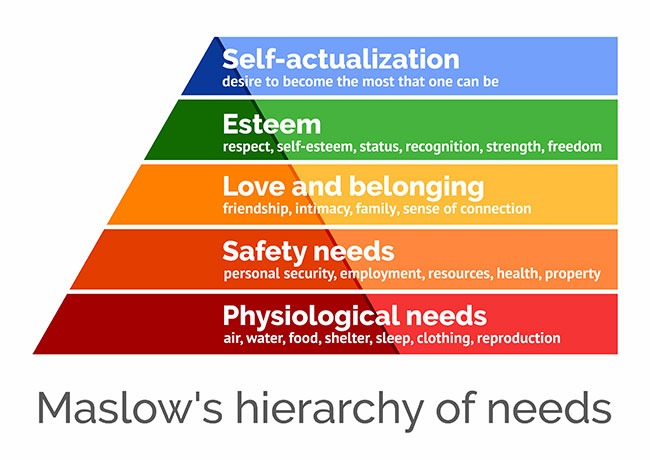
3 tools for stress
By James Rychard
Features firefighter mental health Abraham Maslow believed that we strive to reach the top of the pyramid because this is what makes us “feel” we are living our life’s true potential. Photo: laplateresca/Adobe Stock
Abraham Maslow believed that we strive to reach the top of the pyramid because this is what makes us “feel” we are living our life’s true potential. Photo: laplateresca/Adobe Stock Given the VUCA — volatile, uncertain, complex, ambiguous — world in which we live, stress is a predictable outcome. For firefighters whose work environment is characterized by unpredictable schedules, events, and emergencies as well as erratic sleep and eating patterns, the effects of stress are significant. Stress leaves people vulnerable to negative physical, mental, and behavioral issues. Worse, too much stress causes the immune system to shut down.
COVID-19 has amplified exponentially the negative effects of stress on firefighters, their families, and their communities. Mitigating these effects requires both an understanding of what causes stress and the application of tools to help monitor and manage it. Firefighters need to determine when – not if – their stress levels are reaching their tilt factor, and what they can do about it. This article prescribes three easy-to-use tools.
The Social Readjustment Rating Scale (SRSS)(https://www.stress.org/holmes-rahe-stress-inventory-pdf ), developed by doctors Thomas Holmes and Richard Rahe, assigns points to 43 stress-inducing life events that affect people’s health. The value associated with each Life Change Unit (LCU) is based on its potential impact on one’s stress level. For example, the LCU for divorce is 73, the second most impactful item on the SRRS. An individual simply checks each LCU they have experienced during the previous 12 months and adds their values. Research shows that subjects whose total score exceeds 300 have an 80 per cent chance of illness in the next two years while those whose scores are 150 or less have only a 30 per cent chance. When firefighters determine their current stress level, they can make informed decisions about how to avoid over-taxing themselves.
The second tool, Abraham Maslow’s Hierarchy of Needs, is depicted as a pyramid of human needs (see illustration).
Maslow believed that we strive to reach the top of the pyramid because this is what makes us “feel” we are living our life’s true potential. However, we cannot achieve that level — or any other — unless all of the lower level needs have been satisfied. When that is not the case, motivation and upward progress will be disrupted as people move back down the pyramid. Fluctuating among the lower levels of the hierarchy creates a quagmire effect.
When you superimpose Maslow’s Hierarchy of Needs with the SRRS by placing the LCUs in their corresponding needs categories, it becomes obvious that over 90 per cent of the LCUs fall into the bottom three levels. This means that numerous stressors are likely to interrupt the path to achieving one’s full potential. Firefighters who must deal simultaneously with an excess of stressors may experience decreases in confidence and motivation, leaving them particularly vulnerable to negative physical, mental, and behavioral issues. Learning about the inverse connection between stress and motivation will enable firefighters to make better decisions about how to manage stress.
Thirdly, Gallup’s CliftonStrengths (a business assessment tool found at www.gallup.com/cliftonstrengths/en/253868/popular-cliftonstrengths-assessment-products.aspx) identifies and measures 34 natural talents, encouraging people to focus on their top five talents. It also offers an action-planning guide specific to each strength. Gallup’s research team discovered that people who choose to use their strengths daily report results such as a significantly higher quality of life and level of work engagement than those who make other choices.
Firefighters can become better, stronger, healthier, and more engaged in life by taking three actions:
- understanding the inverse connection between stressors motivation;
- maintaining a high level of situational awareness about their own stress level; and
- playing to their strengths every day.
The three tools described here can help achieve those outcomes.
In addition to being a firefighter and R2MR Instructor from the City of Burlington, Ont., James Rychard is an advocate for mental and behavioural health in the fire service, sitting on multiple association committees. He can be reached at jaymzr007@hotmail.com.
Print this page